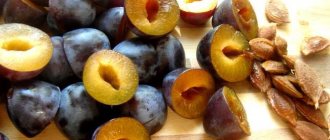What is the value of breast milk
Mother's milk contains all the proteins, fats, vitamins, and carbohydrates necessary for children's digestion. The baby does not need additional sources of nutrients. The close emotional connection that occurs between mother and child during breastfeeding is important.
The composition of breast milk does not remain constant. It changes to meet the needs of the baby at certain periods of his growing up. In the last days before childbirth and up to five days after, colostrum is released from the mammary glands: a thick yellowish liquid that is easily absorbed by the newborn’s digestion, preparing it for the transition to mature milk. Colostrum contains a large amount of phosphatides, components that facilitate digestion. Colostrum contains little fluid and protects the baby's kidneys from overload. It helps the newborn get rid of meconium and reduces the signs of physiological jaundice.
Around the fifth day after birth, transitional milk begins to be released instead of colostrum: an intermediate stage between colostrum and mature milk. The yellowish color gradually changes to white, the amount of proteins decreases, fats and carbohydrates increase. Two weeks after the birth of the baby, the milk becomes mature and contains all the substances for the full development of the child’s body.
Common reasons for a baby to refuse breastfeeding
Many mothers of infants mistake temporary refusal for the natural end of breastfeeding and stop it. Others start panicking out of nowhere, trying to understand why the child spits out the breast and freaks out. They see that during feeding the baby became quiet, turned away, and focused on something else. But this is not a refusal of milk at all: the baby listens to the surrounding atmosphere or is preparing to burp. There can be many reasons for this behavior.
For example, the baby may not be able to immediately attach to the breast. He shakes his head, turns away, licks the nipple, but fails to grab it. You need to gently help your baby latch onto the breast correctly.
The baby may simply not have an appetite or be capricious due to overwork or illness. The baby may go hungry due to painful feeding due to infection, teething, or thrush. Consult your doctor for an accurate diagnosis.
The behavior of children is significantly influenced by the condition of the mother and the environment. The newborn feels the mother’s unwellness, a change in her emotional state (the mother was nervous, she had her monthly period, or she became pregnant again). He may be frightened by his mother's overexcitement, stress, sudden changes in weather, a strong reaction to an action nearby (examination by a doctor, arrival of guests, moving to a new place, crowds of people).
Another reason why a child spits out the breast, freaks out and turns away may be his sensitivity to the mother’s food and medications. He may also not like nipple creams, medications, new shower gels, or other detergents. Temporary refusal of milk in this case is the only way for the child to let him know that he does not like some actions or smells.
The problem may be a short frenulum of the tongue or an abnormal structure of the oral cavity. As they grow older they will return to normal.
The last reason a baby will refuse can be a bottle or pacifier.
How to minimize the causes of problems
The first thing a mother should do is figure out whether the baby is healthy and comfortable. If there are no visible reasons for concern, then you need to objectively evaluate all the associated factors. Is there enough milk being produced? Do you take a comfortable position while feeding? Have there been any stressful situations in your child’s life recently?
Proper nutrition of the mother, daily routine and her calmness are what will help cope with the problem if no other reasons for refusing breastfeeding could be found.
The nipple is one of the problems with breastfeeding
When for some reason a child does not take the breast, cries and freaks out, many mothers try to calm him down with a pacifier. The problem is that the sucking mechanisms of pacifiers and pacifiers are very different. When applied to the breast, he works mainly with the tongue, and when applied to the bottle and nipple - with the cheeks. After the baby tries both options, he chooses the easier one. Some people combine sucking a pacifier with breastfeeding, other babies choose only the breast, but mostly babies refuse the breast in favor of bottles and pacifiers.
The younger the children, the easier it is to wean them from sucking a pacifier or bottle and return them to breastfeeding. If a child cries loudly, turns away from the breast and demands a pacifier, then this is only a habit that can be overcome.
While you are trying to return to breastfeeding, you should not bottle feed or give a pacifier. Supplementary feeding can also be given only on the recommendation of a doctor from a spoon or pipette.
Important! Ignoring the advice will negatively impact your baby's attitude towards breastfeeding. It can cause complete abandonment of it, lead to separation between mother and child, and loss of close emotional connection. In addition, problems with the breasts begin: cracks, lactose, lactation crisis.
Why does the baby not want to breastfeed?
The situation when a child does not take the breast, while freaking out and crying, can worry any new mother. Getting angry at your baby, not feeding him for a long time, or switching him to feeding from a bottle are fundamentally wrong actions. It is important to determine the reason why the baby does not latch on well, and every process of latching is accompanied by crying and whims.
Possible factors leading to the problem:
- The mother's nipples have an incorrect structure, when it is difficult for the baby to latch on to it, he freaks out, arches and cries - anatomical defects, however, cause problems with feeding from the first days.
- Errors of a nursing woman in nutrition - if the mother does not monitor the baby’s reaction to certain foods, he will develop a skin rash, colic, and bloating. The baby refuses to breastfeed and is capricious and sleeps poorly.
- Insufficient or excessive amount of milk in the glands - if there is a lack of nutrition, the baby does not feel full, cries and abandons the breast during feeding. Too much volume, on the contrary, frightens the newborn. He cannot cope with the flow of fluid and stops eating normally.
- Problems with stool - occur at the age of 4-5 months and go away on their own (the child’s body grows, and the digestive system is rebuilt in a new way).
- Early supplementation and bottle feeding - the baby gets used to the fact that milk flows easily from the rubber nipple and refuses to work on “extracting” nutrition from the breast.
- Feeding a baby in an uncomfortable environment - if the baby’s room is too stuffy, hot or, conversely, cold, there are strong smells and loud sounds, he may refuse to breastfeed.
Attention! Sometimes the reason that the baby does not take the breast is not hidden in him at all. For example, when a mother does not regularly change his diapers, rarely changes his clothes or wraps him up, diaper rash and prickly heat appear on the baby’s skin. The affected areas of the skin itch and cause pain to the baby, especially when he is picked up, which is why he freaks out and cries during attachment.
How does proper nutrition affect milk?
If the baby does not want to breastfeed, the young mother should think about her diet. Perhaps the reason lies in a change in the taste of food, as a result of which the baby refuses to eat the iron. First of all, you should pay attention to “stuffy” foods, such as cabbage, legumes, cucumbers and tomatoes, and grapes. In the first months of breastfeeding, it is better to refuse them. Onions and garlic can change the taste of milk. Of course, if a nursing woman ate a clove of garlic, the baby is unlikely to notice a change in the taste of the food. But everything should be in moderation; you should not abuse root vegetables.
Tea, coffee and cocoa are drinks that help a young mother cheer up. But they can have a stimulating effect on the baby, so when breastfeeding, you need to limit their number. You can replace strong tea with chamomile decoction, and coffee with chicory powder; they are not only safer, but also provide health benefits.
The taste of breast milk can also be affected by:
- Sports – with active physical activity, the production of lactic acid in the muscles increases, as well as sweating. It is important to shower before latching your baby and reduce stress.
- Hormonal status - changes occur in the body that affect the taste of milk at the beginning of the menstrual cycle, or during a second pregnancy.
- Alcohol - alcohol penetrates into breast milk and remains there for at least two hours (even 50 ml of liqueur containing 40% alcohol will cause a change in taste).
- Smoking - scientists have found that applying crumbs to the gland immediately after smoking a cigarette causes a bitter taste in the mouth.
- Mastitis – when infected, the milk acquires a salty taste, which is why the baby does not want to suckle.
- Cosmetic procedures - creams, lotions and other body care products, get into the baby's mouth during feeding, so he may refuse to latch on. It is important to wash the glands with water if the baby asks to eat immediately after applying the product to the skin.
Important! Medicines, such as antibiotics and hormonal drugs, can give milk a bitter taste. Their use is not recommended during breastfeeding, but is allowed in case of the development of diseases for which medication cannot be avoided. It is important to endure the period of therapy until the taste of milk is restored and the baby begins to actively latch on to the breast again.
Psychological mood of a nursing mother
Situations when a newborn does not take the breast and constantly freaks out are often provoked by the mother herself, no matter how paradoxical it may sound. The problem may lie in the negative psychological state of the woman caused by prolonged postpartum depression. A young mother should know the symptoms of this condition in order to take action in time:
- frequent bouts of crying;
- rage and anger at the whims of the baby - a woman becomes hysterical when she doesn’t know what to do to make the baby calm down;
- the feeling that there is no support from any of her loved ones, as if they are just waiting for the young mother to make a mistake in order to teach her about life;
- helplessness in the face of circumstances and, as a result, the inability to properly care for the baby;
- irritation from one's own appearance in the mirror.
How to connect postpartum depression and the fact that a newborn refuses to latch on? In the first months of life, babies are closely connected with their mother and depend on her not only physically, but also psychologically. If the baby feels the emotional stress of the mother and the loss of contact with her, he also begins to get irritated, freak out, be capricious and even refuse to breastfeed.
Correct mother behavior: how to overcome the breastfeeding crisis
The breastfeeding crisis affects both the baby and the mother. She may experience a lactation crisis (temporary lack of milk). The reasons may be unreasonable supplementary feeding with formula, insufficient stimulation of the mammary glands. Because of this, a woman’s body begins to produce less milk.
The following actions can help a woman during a lactation crisis:
- Put the baby to the breast every hour.
- Avoid supplementary feeding of the baby with formulas with mandatory weight control; exclude supplementary feeding with water. Supplemental feeding can cause diarrhea.
- Increase the duration of feeding.
- During feeding, feed both breasts in turn.
- Massage will improve the health of the mother, stimulating blood circulation will increase lactation.
- Avoid overworking the mother and free her from household responsibilities.
- Drink at least 2.5 liters per day, drink more hot drinks. The diet is rich in proteins and high in calories.
- Enlist the support of relatives and friends.
In relation to the baby, actions should be as follows:
- The mother should be near him not only during feeding. You need to enjoy communication with your child and ensure skin-to-skin contact. This will increase the baby’s trust in his mother.
- Find a comfortable place for feeding, provide free access to the breast. The mother should relax and not be nervous during feeding, because her irritation will be transferred to the baby.
- Try to put the baby to the breast as soon as he asks or every hour and a half.
- Co-sleeping.
- Avoid contact with strangers.
- Procedures that are unpleasant for a baby should be entrusted to the father or grandmother.
- Avoid contact with the pacifier completely.
- You can try expressing a few drops of milk onto your baby's tongue. When he feels a familiar taste, he may willingly take on the nipple.
Even if none of the above methods help, the mother should not be nervous or scream. She must remain patient and careful, but at the same time persistent in her help to the baby. If a baby abandons the breast, freaks out and cries during feeding, the mother should not raise her voice in response. You need to calm the baby down, turn on leisurely music, and sing him a song.
Reason 5. Runny nose
The baby has a stuffy nose, and this prevents him from sucking milk. During sucking, the baby's lips are tightly pressed to the chest; normally, air does not flow through the mouth at all. And if it does, it goes into the stomach rather than into the lungs, which causes belching beyond measure. That’s why it’s so important to breathe freely through your nose.
You can clean the spout with a spray of sea water, such as Aquamaris. Apart from this, I have never used anything on Eva for a runny nose. Well, even during periods of colds, our whole family begins to drink ginger drink with lemon or cranberry juice, eat raspberry jam and citrus fruits.
Nutrition tips for a nursing mother
The value, composition and taste of breast milk directly depend on the mother’s nutrition during the feeding period. The postpartum diet should include all food groups, but mainly healthy foods.
Most mothers should limit themselves to the following products:
- strong coffee and tea, which have a stimulating effect on the nervous system of both mother and baby;
- alcohol, smoking;
- legume products, fatty, fried and smoked foods.
The nutrition of a nursing mother will differ little from the usual balanced diet of a woman. The only difference is that you need to consume about 500-600 more calories than before giving birth.
This does not apply to the diet of a mother with an allergic child. They need to exclude all allergenic foods from the diet, introduce them gradually in small portions, monitoring the baby’s reaction.










